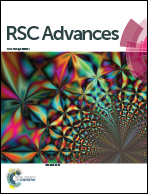Sea salt as a potential ocean mirror material†
Abstract
One way to increase planetary albedo in order to ameliorate global warming is to use ocean foams. The energy needed to maintain such foams, even if drawn from wave or wind is high and so they must be persistent, ideally surviving up to a month. While studying combinations of surfactants and gelling agents to make long-lived foams in salt water, it was apparent that some foams developed progressively higher reflectance as the upper surface dried. Scanning electron microscopy of the upper surface revealed 0.5 μm, near-monodisperse salt crystals. Thus with a refractive index of ∼1.5, sea salt, being in somewhat prodigious supply, now enters the arena as a potential mirror material. Its reflectance depends on the microstructure, specifically on the inhibition of Ostwald ripening. Studies were therefore carried out to investigate particle size effects in a membrane such as a foamed gel in which seawater dries on the upper surface. It was demonstrated that the organic additives used to create foam persistence also mediated sea salt crystallisation and in this way drastically modified the reflectance of the upper layer. These experiments suggest a new direction of research in planetary surface albedo modification.


 Please wait while we load your content...
Please wait while we load your content...